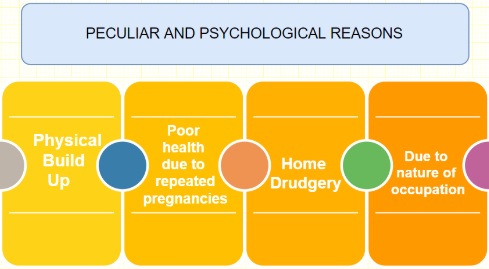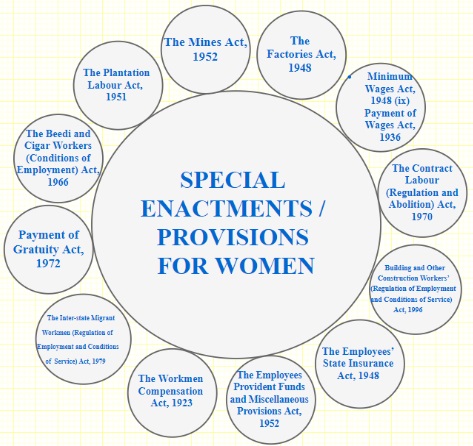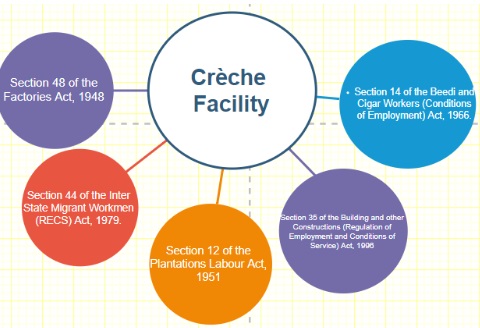In this article, Kabir Jaiswal discusses Women’s Rights and Labour Law Statutes in India.
- India’s Labor Force Will Soon Become the Largest in the World. According to the information provided by the office of Registrar General & Census Commissioner of India, As per Census 2011, the total number of female workers in India is 149.8 million and female workers in rural and urban areas are 121.8 and 28.0 million respectively.
- Out of total 149.8 million female workers, 35.9 million females are working as cultivators and another 61.5 million are agricultural laborers.
- Of the remaining females workers, 8.5 million are in household Industry and 43.7 million are classified as other workers.
Our late Prime Minister Honorable Jawaharlal Nehru has observed that
“to awaken the people it is the woman who must be awakened, once she is on the move, the family moves, the village moves, the nation moves.”
Labors are being Subject to misuse and discrimination and their human rights being damaged so the need emerged for an order of the laws for their assurance and security. Working ladies shape a noteworthy proportion of society. Among – workers, the states of women are especially helpless & hapless thus numerous administrative enactments have been given in all work resolutions which address issues of women who work. Women fundamentally require some protection due to the accompanying reasons:

The Second National Commission on labor, 2002
The Commission has also justified the protective discriminatory legislation in favor of women by recommending that all such legislation are necessary for women workers.
As rightly mentioned by our honorable Prime Minister Mr. Narendra Modi in one of his speeches,
“Women constitute 50% of our population and if they do not come out and work, then our country will never grow at the pace we all envision it to grow, and for that very reason, governments over time have taken special care to enact and amend laws to ensure greater participation of women in the growth story of India”.
From time immemorial women have confronted biased test. In this era too, as an ever-increasing number of young educated women go into clerical employment, their odds of confronting ruthless conduct from men—at various word related dimensions—have increased.
Click Here
Protection for Women in Labour Statutes:
While there are multiple statutes aimed only at women, such as the Sexual harassment at Workplace Act, Maternity Benefits Act, etc., a number of other statutes that are aimed at the general working populace have special provisions for the welfare of women workers, namely:

Crèche Facility for Women Employees:
As per the provisions under Section 48 of the Factories Act, 1948 “Any factory employing 30 or more women workers are required to provide creche facilities for the use of children under the age of 6 years for the women employees.”
Provision for crèches exists under the following:
- The Factories Act, 1948;
- The Mines Act, 1952;
- The Plantation Labour Act, 1951;
- The Building and Other Construction Workers’ (Regulation of Employment and Conditions of Service) Act, 1996;
- The Beedi and Cigar Workers (Conditions of Employment) Act, 1966;
- The Contract Labour (Regulation and Abolition) Act, 1970;
- The Inter-State Migrant Workmen (Regulation of Employment and Conditions of Service) Act, 1979.
Safety/Health Measures
| 1. | Section 22 (2) | The Factories Act, 1948 | Provides that no woman shall be allowed to clean, lubricate or adjust any part of a prime mover or of any transmission machinery while the prime mover or transmission machinery is in motion |
| 2. | Section 27 | The Factories Act, 1948 | Prohibits employment of women in any part of a factory for pressing cotton in which a cotton-opener is at work. |
| 3. | Section 34 | The Factories Act, 1948 | No woman employee shall lift, carry, or move by hand or on the head of any material, article, tools, or appliance exceeding the maximum limit in weight of 30 kilograms |
| 4. | Section 46 (2) (d) | The Factories Act, 1948 | There shall be at least one women (worker) on the Canteen Managing Committee. |
| 5. | Section 41, Section 43, | Contract Labour (Regulation and Abolition) Act, 1970 | Separate Restrooms and Canteens |
| 6. | Section 40, Section 41 | The Inter-State Migrant Workmen (Regulation of Employment and Conditions of Service) Act, 1979 | Separate Restrooms and Canteens |
Prohibition of work in Hazardous Occupations
- Section 22(2) of the Factories Act, 1948 prohibits women to work with machinery in motion or in any case whatsoever.
- Also Section 87 of the Factories Act, 1948 empowers the State Government to prohibit employment of women in dangerous operations.
- The Factories Act also prohibits the employment of women in pressing cotton where a cotton-opener is at work. There is a proviso that if the feed end of a cotton-opener is in a room separated from the delivery end by a partition to the roof or to such height as the inspector may in any particular case specify in writing, women may be employed on the side of the partition where the feed end is situated under Section 27.
- Section 34 states that Maximum Permissible Load To safeguard women against the dangers arising out of lifting to heavyweight, the Factories Act authorize the appropriate Governments to fix the maximum load that may be lifted by women. Rules framed by all the State Governments (Except U.P.) have fixed the following maximum weights for women employed in factories.
| 1. | Adult | Females | 65 lbs |
| 2. | Adolescent | Females | 55 lbs |
| 3. | Children | Female | 30 lbs |
Turning Point Precedents
- In Pearson v. Belgium Co. Ltd., The question was whether a woman could clean the stationary parts of a machine if the machine as a whole is in motion. The Court held that even stationary parts of the machine could not be cleaned by a woman if the machinery as a whole is in motion.
- Also, In Richard Thomas and Baldwins Ltd. v. Cummings, The Court noted that there would be no breach of statutory duty if an injury occurred while the machinery was not enclosed, if the power was cut off and the machinery was under repair and the parts were not in motion but were moved by hand for repair purposes.
- In a landmark case of B.N. Gamadia v. Emperor, the Bombay High Court observed that the provisions of the Section are not complied with if the door is divided between the two parts of the room and opened by a woman employed while the door is shut, but not locked or if other effective means are taken to prevent the door from being opened by a woman.
Prohibition of Night Work
| 1. | Section 66 (1) (b) | The Factories Act, 1948 | States that no woman shall be required or allowed to work in any factory except between the hours of 6 a.m. and 7 p.m. |
| 2. | Section 25 | The Beedi and Cigar Workers (Conditions of Employment) Act, 1966 | Stipulates that no woman shall be required or allowed to work in any industrial premise except between 6 a.m. and 7 p.m. |
| 3. | Section 46 (1) (b) | The Mines Act, 1952 | Prohibits employment of women in any mine above ground except between the hours of 6 a.m. and 7 p.m. |
| 4. | – | Shops and Establishment Act, 1953 | No women shall be required or allowed to work in any establishment after 9:30 PM |
| 5. | Section 25 | The Plantation Labour Act, 1951 | Except with the permission of the State Government, no woman or child worker shall be employed in any plantation otherwise than between the hours of 6 a.m. and 7 p.m.: Provided that nothing in this section shall be deemed to apply to midwives and nurses employed as such in any plantation. |
| 6. | – | The Inter-State Migrant Workmen (Regulation of Employment and Conditions of Service) Act, 1979 | No women shall be required or allowed to work in any establishment after 9:30 PM |
In Triveni K.S. and Others v. Union of India and others, Section 66(1)(b) of the Constitution was challenged to be discriminatory on the basis of sex. The High Court held that women should not be employed for their own safety and welfare even during the night was an ideology of an erstwhile age that was out of tune with modern requirements for equality, especially between sexes. With regard to an exception provided to the fishing and canning industry, this was postulated that it would seem a ludicrous assertion that women in these sectors would be completely safe but still not safe in the textile industry. Consequently, Section 66(1)(b) of the Act was ruled unconstitutional by the High Court and proclaimed that females in the fishing industry should also be given more or less the same protection as some of those provided for.
Provisions for Separate Latrines and Urinals
| 1. | Section 19 | The Factories Act | 1948 |
| 2. | Section 20 | The Mines Act | 1952 |
| 3. | Section 9 | Plantations Labour Act | 1951 |
| 4. | Rule 42 | The Inter-State Migrant Workmen (RECS) Central Rules | 1980 |
| 5. | Rule 53 | The Contract Labour (Regulation and Abolition) Act | 1970 |
| 6. | – | The Building and Other Construction Workers’ (Regulation of Employment and Conditions of Service) Act | 1996 |
| 7. | – | The Beedi and Cigar Workers (Conditions of Employment) Act | 1966 |
Latrine and Urinal Facilities Separate conservancy facilities are provided to women workers in Factories Act, 1948.
- The Factories Act, 1948 makes it obligatory for every factory to maintain an adequate number of latrines and urinals of the prescribed type separately for men and women workers.
- Such facilities are to be conveniently situated and accessible to workers at all times while they are in the factory.
- Every latrine is required to be undercover and so partitioned off as to secure privacy and have a proper door and fastenings.
- Sweepers are required to be employed to keep latrines, urinals and washing places clean.
- Standard of construction and the scale of the latrine accommodation to be provided for men and women workers are contained in the rules framed by the concerned state government.
Provisions for Separate Washing Facilities:
| 1. | Section 42 | The Factories Act | 1948 |
| 2. | Section 43,
Section 41 (4), Section 41 (9)(ii) |
The Inter-State Migrant Workmen (RECS) Act | 1979 |
| 3. | Section 57,
Section 44 |
The Contract Labour (Regulation and Abolition) Act | 1970 |
| 4. | Section 34 | The Building and Other Construction Workers’ (Regulation of Employment and Conditions of Service) Act | 1996 |
According to Section 42 (1)(b) of the Factories Act,1948 separate and adequately screened washing facilities shall be provided for the use of male and female workers. Such facilities shall be conveniently accessible and shall be kept clean. However, the State Government is empowered to prescribe standards of adequate and suitable facilities for washing.
Prohibition of Sub-terrain Work
Section 46(1)(b) of the Mines Act, 1952 prohibits employment of women in any part of a mine which is below ground.
Provisions of Information Center under Factories Act, 1948
Each factory shall set up an information center for female workers to provide them with information on the protection measures in accordance with the law and the rules.
The Factories Act, 1948 (“Factories Act”)
The Aim & Object of the Act:
To safeguard the interest of workers and protect them from exploitation, the Act prescribes certain standards with regard to safety, welfare and working hours of workers, apart from other provisions. The Factories Act aims at protecting workers employed in factories from unfair exploitation by their employers. Proper working conditions include ensuring health, safety, welfare, proper working hours, leave, and other benefits.
Exclusive Provisions for Women Workers
- There are also numerous other facilities to be offered to factory workers, such as women’s washing and bathing facilities, toilets( separate latrines and urinals for women), toilets and canteens. Public utility amenities will be offered separately for women at work.
- A female worker shift timing need not be altered except after a weekly holiday or a totally different holiday. Thus, employees (female) now have the right to receive at least a 24-hour notice for their change in shift timing.
- Female workers are prohibited from working in a dangerous occupation, from pressing cotton where a cotton-opener is at work and from limiting the maximum allowable load.
- The Factories Act also stipulates the employers employing 30 or more women workers to provide for cheches for children of the women workers, aged 6 years and below.
- No woman worker shall be allowed to work in a factory except between 6 a.m. and 7 p.m. The State Governments may by notification vary the limits as set out in this point, but in no circumstance will women employees be allowed to work between 10 p.m. and 5 a.m.
In 1987, the Act was amended, establishing safeguards against its use and handling of hazardous materials and protocols for the establishment of hazardous industries.
The Equal Remuneration Act, 1976 (“Equal Remuneration Act”)
Here again, we find discussions and cases of wage discrimination, in which women workers are paid less than their male counterparts. This is a story throughout the world, even in developed countries.
Article 39 of our Constitution directs that “States shall, in particular, have policies towards securing equal pay for equal work for both men and women.”
Under the Equal Remuneration Act:
- Employers shall pay equal pay to man and a woman who perform the same or even similar work.
- Employers could not legally discriminate between men and women in the recruitment process unless there is a legal limit to the employment of females in certain sectors.
ILO Convention & Constitution
The establishment of the International Labour Organisation in 1919 influenced considerably the activities of the State in this field. Most of these laws have been inspired by the Conventions and Recommendations adopted by the International Labour Organisation.
Promotion of equality in employment is positive enforcement, unlike prevention of discrimination, which is a sort of negative right or negative equality. This involves breaking down both horizontal and vertical occupational segregation.
The ILO Constitution of 1919, and the ILO Convention on Equal Remuneration 1951, both recognize the principle of “equal pay for work of equal value.” This is also enshrined in the Constitution of India under Articles 14 and 15, as well as the Equal Remuneration Act of 1976. Despite such recognition often the issue of equal pay for women workers goes un-championed, even by trade unions, as they often do not view this to be a problem that affects the workers as a whole.
Another cause for a disparity in income is that a majority of the active female workforce is involved in the informal sector, such as agriculture and domestic work, which have very few regulations in terms of remuneration and social security.
Other Enactments
In addition to the above- mentioned laws, there are some other statutes for the welfare and protection of female factory workers. Furthermore, female workers should be made aware of various acts providing social security for them:
- The Employee’s Provident Fund & Miscellaneous Provisions Act, 1952;
- The Employees State Insurance Act, 1948;
- Payment of Gratuity Act, 1972;
- Payment of Bonus Act, 1965, etc.
What is the need for Special Protection for Women?
- While women constitute a substantial chunk of the available workforce in India, they are still lacking in work participation (the percentage of women employed is still low) as well as the quality of employment.
- One of the reasons for this lack of this female labor participation is the lack of suitable jobs on offer, i.e. the disparity between what they can do and what is available to them.
- The question of safety is another reason for low female participation in the field of employment. Good governance and law enforcement is a must if the intention is to increase women’s sense of security and thereby encourage more women to take up jobs.
- Another problem is that the sectors that women are employed in such as “domestic work” fall under the “unorganized sector” and this is problematic in the sense that there is no strong set of workplace rules in place; this again is a factor that leads to the lack of women in the active workforce, as it is incredibly hard to simply maintain a job let alone build a career.
- This vulnerable position of women in terms of adverse conditions is only worsened by any possible sudden negative impact upon the industry as they are already dealing with unequal intrinsic situations.
- They have to cope with childbirth and related issues, they have also to deal with domestic responsibility, which in a patriarchal society is not much of a concern to men, etc.
Conclusion
It can be seen from the multiple special provisions created for the welfare of women that both at the national and international levels, there has been a movement towards the empowerment of women in labor law. There has been a transparent move towards creating equal pay, equal access to opportunity, bar, and redressal of harassment and provision of maternity benefits a reality in Republic of India. in fact, a majority of laws in respect to the special provisions for women are modeled after the International Labour Organization conventions.
India being a founding member of the International Labour Organization has tried terribly onerous to stick to the standards provided by the International Labour Organization : The special rights provided to women in various labour laws (i.e. The Factories Act, 1948, The Mines Act, 1952, The Plantation Labour Act, 1951, The Building and Other Construction Workers’ (Regulation of Employment and Conditions of Service) Act, 1996, The Beedi and Cigar Workers (Conditions of Employment) Act, 1966, The Contract Labour (Regulation and Abolition) Act, 1970, The Inter-State Migrant Workmen (Regulation of Employment and Conditions of Service) Act, 1979, The Maternity Benefit Act, 1961, The Employees’ State Insurance Act, 1948, The Employees’ Provident Funds and Miscellaneous Provisions Act, 1952, The Payment of Gratuity Act, 1972, and The Workmen’s Compensation Act, 1923, Minimum Wages Act, 1948, Payment of Wages Act, 1936 and Equal Remuneration Act, 1976) are proof of this.
However, it is important to note that some of these protective legislations have backfired and proved to be counterproductive in nature. The only way to solve such issues in socially rather than legally, i.e. by making the work environment safer through social intervention, legal rules that are paternalistic in nature can be relaxed. The next level of effort that India needs to make is to develop effective implementation and redressal mechanisms. The best way to ensure effective implementation of these provisions and redressal of any complaints is to begin implementation at a grassroots level, i.e. at the level of individual enterprises, and employers. This will ensure that the actions are more specific in nature and will bring about more concrete outcomes.
 Serato DJ Crack 2025Serato DJ PRO Crack
Serato DJ Crack 2025Serato DJ PRO Crack










 Allow notifications
Allow notifications




i am working in multinational company from july-19192 i suffer from blood cancer from june 2007 company not help me they torture me if work performance is not met then they fire me job dismiss from job,i want to say that when i join company that time i am fit i work for company day night if toady i suffer such a critical disease what is responsibility of company towards to me as a employers what are rule of labour law against us which type of help should company towards me please guide me